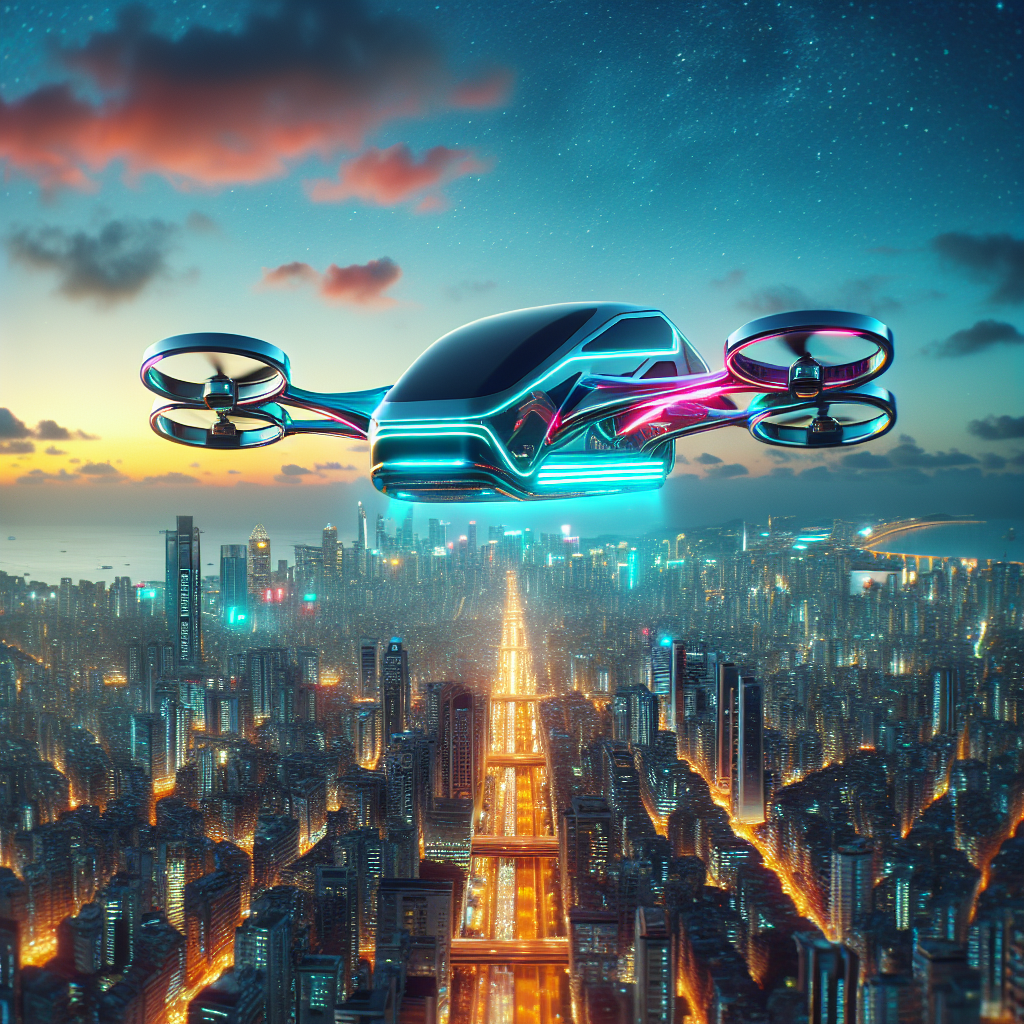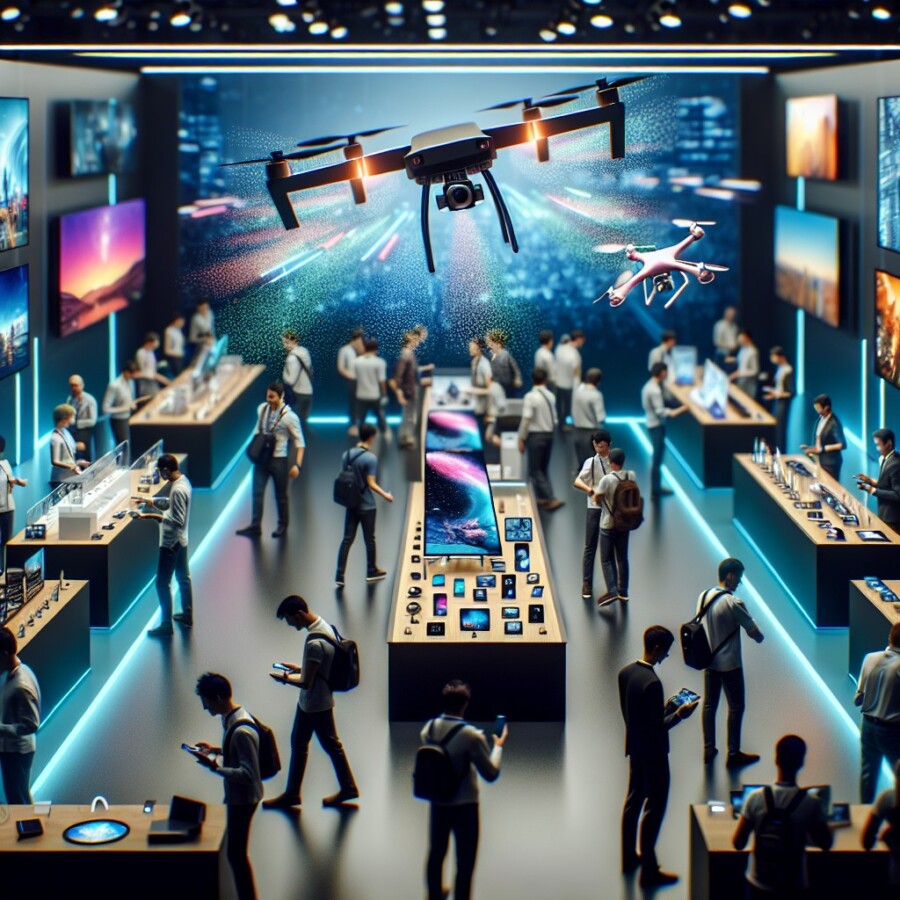The UK government has announced plans for flying taxis to become a regular sight in the skies by 2028. The Future of Flight action plan, developed in collaboration with the aerospace industry, also predicts that drones and other flying vehicles will become more autonomous. The plan suggests that the first pilotless flying taxi will take off in 2030. However, experts believe that there are several obstacles that need to be overcome, such as infrastructure development and public acceptance.
Flying taxis, also known as eVTOLs (electric vertical take-off and landing aircraft), are futuristic-looking vehicles that resemble helicopters and can typically carry around five people. While the technology for flying taxis already exists, they are currently considered exclusive modes of transport, replacing expensive helicopter journeys. The Department for Transport also plans to allow drones to fly beyond visual line of sight, which would enable tasks such as transporting medical supplies, delivering post in rural areas, and tracking down criminals.
Infrastructure and public perception are the main challenges in getting flying taxis off the ground, according to Craig Roberts, head of drones at consultancy firm PwC. The government’s report suggests that flying from Liverpool to Leeds could take just 26 minutes. However, the convenience and efficiency of flying taxis would need to be demonstrated to the wider public, including advances in security screening technology. The report also acknowledges the need for new infrastructure developments, such as “mini airports” for drones, which would require significant investment.
While there have been some trial mini airports in the UK, there is still a need for further infrastructure development to support the operation of flying taxis. The government plans to have the first vertiport (airport for vertical vehicles) operational this year, and the Civil Aviation Authority is consulting on proposals for vertiports at existing aerodromes. New regulations would also need to be created to support the government’s aim of introducing autonomous air taxis by 2030.
Overall, while there are challenges to overcome, experts believe that the goal of having flying taxis in the air by 2028 is realistic. The government’s plans, along with industry collaboration and technological advancements, are expected to pave the way for the future of flight in the UK.
Original news source: Government wants flying taxis taking off in 2 years (BBC)
🎧 Listen:
Slow
Normal
Fast
📖 Vocabulary:
| 1 | aerospace | Relating to the design, development, and production of aircraft and space vehicles |
| 2 | autonomous | Operating independently without human intervention |
| 3 | eVTOLs | Electric aircraft capable of vertical take-off and landing |
| 4 | infrastructure | The basic physical and organizational structures needed for the operation of a society or enterprise |
| 5 | pilotless | Operating without a human pilot on board |
| 6 | futuristic | Characteristic of or involving thinking about the future, often with advanced technology |
| 7 | exclusive | Restricted to the use of a small number of people or a specific group |
| 8 | perception | The way in which something is regarded, understood, or interpreted |
| 9 | vertiport | A specialized airport designed for vertical take-off and landing vehicles |
| 10 | aerodromes | Places where aircraft can take off and land, equipped with facilities for their operation |
| 11 | regulations | Official rules or directives made by a governing authority to regulate conduct |
| 12 | collaboration | The act of working together towards a common goal |
| 13 | advancements | Developments or improvements that represent steps forward in technology or methods |
| 14 | obstacles | Challenges or difficulties that need to be overcome |
| 15 | efficiency | The ability to perform tasks in the best possible manner with the least waste of time and effort |
Group or Classroom Activities
Warm-up Activities:
– News Summary
Instructions: In pairs or small groups, students will read the article and then write a summary of the main points. They should focus on the UK government’s plans for flying taxis, the challenges that need to be overcome, and the potential benefits of this mode of transportation. After writing their summaries, they can share them with the class and compare their responses.
– Word Association
Instructions: As a warm-up, the teacher will choose a word related to the article, such as “technology” or “autonomous,” and say it out loud. Students will then take turns saying the first word that comes to their mind in relation to that word. For example, if the word is “technology,” a student might say “innovation” or “advancement.” This activity will help students activate their prior knowledge and build vocabulary related to the topic.
– Opinion Poll
Instructions: In pairs or small groups, students will discuss their opinions on the idea of flying taxis. They should consider the potential benefits, such as faster travel times and reduced traffic congestion, as well as the challenges, such as infrastructure development and public acceptance. After discussing their opinions, each group will present their findings to the class, highlighting the different perspectives and arguments presented.
– Sketch It
Instructions: In pairs, students will take turns describing a flying taxi based on the description in the article. The other student will then sketch the vehicle based on their partner’s description. After both students have had a turn, they can compare their sketches and discuss the similarities and differences. This activity will encourage students to practice their descriptive language skills and visualize the concept of flying taxis.
– Future Predictions
Instructions: In small groups, students will brainstorm and discuss their predictions for the future of transportation, specifically focusing on flying taxis and other autonomous vehicles. They should consider the potential impact on society, the environment, and individual travel habits. After discussing their predictions, each group will present their ideas to the class and engage in a discussion about the possibilities and challenges of these future technologies.
🤔 Comprehension Questions:
1. What is the UK government’s plan for flying taxis?
2. What obstacles need to be overcome in order for flying taxis to become a regular sight in the skies?
3. What are flying taxis also known as?
4. What tasks could drones potentially be used for beyond visual line of sight?
5. What are the main challenges in getting flying taxis off the ground according to Craig Roberts?
6. How long could a flight from Liverpool to Leeds take with flying taxis?
7. What infrastructure developments are needed to support the operation of flying taxis?
8. What needs to be done in order to introduce autonomous air taxis by 2030?
Go to answers ⇩
🎧✍️ Listen and Fill in the Gaps:
The UK government has announced plans for flying taxis to become a regular sight in the skies by 2028. The Future of Flight action plan, developed in collaboration with the aerospace industry, also predicts that drones and (1)______ flying vehicles will become more autonomous. The plan (2)______ that the first (3)______ flying taxi will take off in 2030. However, experts (4)______ that there are several obstacles that need to be overcome, such as infrastructure development and public acceptance.
Flying taxis, also known as eVTOLs (electric vertical take-off and landing aircraft), are futuristic-looking vehicles that resemble helicopters and can typically carry around five people. While the technology for flying taxis already exists, they are currently (5)______ exclusive modes of transport, replacing expensive helicopter journeys. The Department for (6)______ also plans to allow drones to fly beyond visual line of sight, which would enable tasks such as (7)______ medical supplies, delivering post in rural areas, and tracking down criminals.
(8)______ and public perception are the main challenges in getting flying taxis off the ground, according to Craig Roberts, head of drones at consultancy firm PwC. The government’s (9)______ suggests that flying from Liverpool to Leeds could take just 26 minutes. However, the convenience and efficiency of flying taxis would need to be demonstrated to the wider public, including advances in (10)______ screening technology. The report also acknowledges the need for new infrastructure developments, such as “mini airports” for drones, which would (11)______ significant investment.
While there have been some (12)______ mini airports in the UK, there is still a need for further infrastructure development to support the operation of flying taxis. The government plans to have the first (13)______ (airport for (14)______ vehicles) operational this year, and the Civil Aviation Authority is consulting on proposals for vertiports at existing aerodromes. New regulations would also need to be created to support the government’s aim of introducing autonomous air taxis by 2030.
Overall, while there are challenges to overcome, experts believe that the goal of having flying taxis in the air by 2028 is realistic. The government’s plans, along with (15)______ collaboration and technological advancements, are expected to pave the way for the future of (16)______ in the UK.
Go to answers ⇩
💬 Discussion Questions:
Students can ask a partner these questions, or discuss them as a group.
1. What is your opinion on the idea of flying taxis becoming a regular sight in the skies?
2. How would you feel if you could take a flying taxi instead of a regular taxi or public transportation?
3. Do you think flying taxis would be a more efficient mode of transportation? Why or why not?
4. What do you think are the main obstacles that need to be overcome in order to make flying taxis a reality?
5. How do you think the public would react to the introduction of flying taxis? Why?
6. Do you like the idea of drones delivering post in rural areas? Why or why not?
7. How do you think the development of flying taxis would impact the job market for pilots and taxi drivers?
8. What are some potential benefits of using flying taxis for medical supply transportation?
9. How do you think the introduction of flying taxis would affect the environment?
10. What do you think are the advantages and disadvantages of having autonomous air taxis?
11. How would you feel about flying in a pilotless flying taxi? Why?
12. Do you think the convenience of flying taxis would outweigh any potential security concerns? Why or why not?
13. How do you think the development of infrastructure for flying taxis would impact the economy?
14. What are some potential challenges in creating new regulations to support autonomous air taxis?
15. How do you think the introduction of flying taxis would change the way people travel and commute? Why?
Individual Activities
📖💭 Vocabulary Meanings:
Match each word to its meaning.
Words:
1. aerospace
2. autonomous
3. eVTOLs
4. infrastructure
5. pilotless
6. futuristic
7. exclusive
8. perception
9. vertiport
10. aerodromes
11. regulations
12. collaboration
13. advancements
14. obstacles
15. efficiency
Meanings:
(A) Characteristic of or involving thinking about the future, often with advanced technology
(B) A specialized airport designed for vertical take-off and landing vehicles
(C) Operating independently without human intervention
(D) Challenges or difficulties that need to be overcome
(E) Places where aircraft can take off and land, equipped with facilities for their operation
(F) Relating to the design, development, and production of aircraft and space vehicles
(G) Operating without a human pilot on board
(H) Official rules or directives made by a governing authority to regulate conduct
(I) Electric aircraft capable of vertical take-off and landing
(J) Developments or improvements that represent steps forward in technology or methods
(K) The way in which something is regarded, understood, or interpreted
(L) Restricted to the use of a small number of people or a specific group
(M) The act of working together towards a common goal
(N) The basic physical and organizational structures needed for the operation of a society or enterprise
(O) The ability to perform tasks in the best possible manner with the least waste of time and effort
Go to answers ⇩
🔡 Multiple Choice Questions:
1. What is the UK government’s plan for flying taxis?
(a) To ban them from flying in UK airspace
(b) To develop them into fully autonomous vehicles by 2028
(c) To replace all traditional taxis with flying taxis by 2028
(d) To make them a regular sight in the skies by 2028
2. What are flying taxis also known as?
(a) Drones
(b) eVTOLs
(c) Helicopters
(d) Autonomous vehicles
3. What is one potential use for drones according to the Department for Transport?
(a) Transporting medical supplies
(b) Replacing traditional taxis
(c) Carrying out surveillance on the public
(d) Racing in drone competitions
4. What are the main challenges in getting flying taxis off the ground?
(a) Technological advancements and government regulations
(b) Infrastructure development and public acceptance
(c) Security screening technology and industry collaboration
(d) Investment and new regulations
5. How long does the government’s report suggest a flight from Liverpool to Leeds could take in a flying taxi?
(a) 1 hour
(b) 2 hours
(c) 26 minutes
(d) 4 hours
6. What is a “vertiport”?
(a) A type of flying taxi
(b) A new type of airport in the UK
(c) A mini airport for drones
(d) An airport for vertical vehicles
7. When does the government aim to introduce autonomous air taxis?
(a) 2030
(b) 2028
(c) This year
(d) It is not mentioned in the article
8. What is the overall outlook for the goal of having flying taxis in the air by 2028?
(a) Unlikely, due to public opposition
(b) Achievable, with current technology
(c) Realistic, with challenges to overcome
(d) Unrealistic, due to lack of industry collaboration
Go to answers ⇩
🕵️ True or False Questions:
1. The first pilotless flying taxi is expected to take off in 2030.
2. The UK government plans to have flying taxis in the skies by 2028.
3. The Department for Transport plans to allow drones to fly beyond visual line of sight for tasks such as transporting medical supplies and delivering post.
4. The Future of Flight action plan predicts that drones and other flying vehicles will become less autonomous.
5. New infrastructure developments, such as “micro airports” for drones, would not be required for flying taxis to operate.
6. The government aims to introduce autonomous air taxis by 2030, but new regulations may not need to be created to support this goal.
7. Flying taxis are not currently considered exclusive modes of transport, replacing expensive helicopter journeys.
8. Infrastructure development and public acceptance are obstacles that need to be overcome for flying taxis to become a reality.
Go to answers ⇩
📝 Write a Summary:
Write a summary of this news article in two sentences.
Writing Questions:
Answer the following questions. Write as much as you can for each answer.
1. What is the UK government’s plan for flying taxis?
2. What are some potential uses for drones beyond visual line of sight?
3. What are the main challenges in getting flying taxis off the ground?
4. What infrastructure developments are needed to support the operation of flying taxis?
5. What is the government’s goal for introducing autonomous air taxis?
✅ Answers
🤔✅ Comprehension Question Answers:
1. The UK government plans for flying taxis to become a regular sight in the skies by 2028.
2. The obstacles that need to be overcome include infrastructure development and public acceptance.
3. Flying taxis are also known as eVTOLs (electric vertical take-off and landing aircraft).
4. Drones could potentially be used for tasks such as transporting medical supplies, delivering post in rural areas, and tracking down criminals.
5. According to Craig Roberts, the main challenges in getting flying taxis off the ground are infrastructure development and public perception.
6. A flight from Liverpool to Leeds could take just 26 minutes with flying taxis, according to the government’s report.
7. New infrastructure developments, such as “mini airports” for drones, are needed to support the operation of flying taxis.
8. New regulations need to be created in order to support the government’s aim of introducing autonomous air taxis by 2030.
Go back to questions ⇧
🎧✍️✅ Listen and Fill in the Gaps Answers:
(1) other
(2) suggests
(3) pilotless
(4) believe
(5) considered
(6) Transport
(7) transporting
(8) Infrastructure
(9) report
(10) security
(11) require
(12) trial
(13) vertiport
(14) vertical
(15) industry
(16) flight
Go back to questions ⇧
📖💭✅ Vocabulary Meanings Answers:
1. aerospace
Answer: (F) Relating to the design, development, and production of aircraft and space vehicles
2. autonomous
Answer: (C) Operating independently without human intervention
3. eVTOLs
Answer: (I) Electric aircraft capable of vertical take-off and landing
4. infrastructure
Answer: (N) The basic physical and organizational structures needed for the operation of a society or enterprise
5. pilotless
Answer: (G) Operating without a human pilot on board
6. futuristic
Answer: (A) Characteristic of or involving thinking about the future, often with advanced technology
7. exclusive
Answer: (L) Restricted to the use of a small number of people or a specific group
8. perception
Answer: (K) The way in which something is regarded, understood, or interpreted
9. vertiport
Answer: (B) A specialized airport designed for vertical take-off and landing vehicles
10. aerodromes
Answer: (E) Places where aircraft can take off and land, equipped with facilities for their operation
11. regulations
Answer: (H) Official rules or directives made by a governing authority to regulate conduct
12. collaboration
Answer: (M) The act of working together towards a common goal
13. advancements
Answer: (J) Developments or improvements that represent steps forward in technology or methods
14. obstacles
Answer: (D) Challenges or difficulties that need to be overcome
15. efficiency
Answer: (O) The ability to perform tasks in the best possible manner with the least waste of time and effort
Go back to questions ⇧
🔡✅ Multiple Choice Answers:
1. What is the UK government’s plan for flying taxis?
Answer: (d) To make them a regular sight in the skies by 2028
2. What are flying taxis also known as?
Answer: (b) eVTOLs
3. What is one potential use for drones according to the Department for Transport?
Answer: (a) Transporting medical supplies
4. What are the main challenges in getting flying taxis off the ground?
Answer: (b) Infrastructure development and public acceptance
5. How long does the government’s report suggest a flight from Liverpool to Leeds could take in a flying taxi?
Answer: (c) 26 minutes
6. What is a “vertiport”?
Answer: (d) An airport for vertical vehicles
7. When does the government aim to introduce autonomous air taxis?
Answer: (a) 2030
8. What is the overall outlook for the goal of having flying taxis in the air by 2028?
Answer: (c) Realistic, with challenges to overcome
Go back to questions ⇧
🕵️✅ True or False Answers:
1. The first pilotless flying taxi is expected to take off in 2030. (Answer: True)
2. The UK government plans to have flying taxis in the skies by 2028. (Answer: True)
3. The Department for Transport plans to allow drones to fly beyond visual line of sight for tasks such as transporting medical supplies and delivering post. (Answer: True)
4. The Future of Flight action plan predicts that drones and other flying vehicles will become less autonomous. (Answer: False)
5. New infrastructure developments, such as “micro airports” for drones, would not be required for flying taxis to operate. (Answer: False)
6. The government aims to introduce autonomous air taxis by 2030, but new regulations may not need to be created to support this goal. (Answer: False)
7. Flying taxis are not currently considered exclusive modes of transport, replacing expensive helicopter journeys. (Answer: False)
8. Infrastructure development and public acceptance are obstacles that need to be overcome for flying taxis to become a reality. (Answer: True)
Go back to questions ⇧











